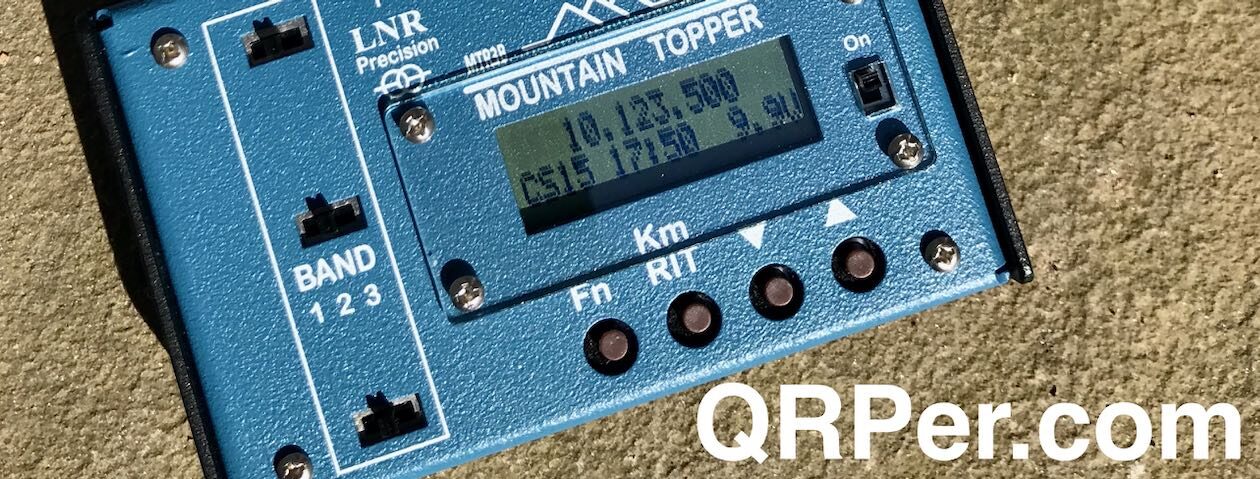Many thanks to Hamilton (KD0FNR) who shares the following article about his portable field radio kit which will be featured on our Field Kit Gallery page. If you would like to share your field kit with the QRPer community, read this post.
Rockmite 20 and Tuna Topper Pack QRP Punch
by Hamilton (KD0FNR)
Our ham radio field kit—in my mind—revolves around simplicity. I’ll walk you through a lot of details, because we have a blast with the field kit and I love talking about it. At the end of the day, it’s a kit radio and amplifier housed in a couple of cans with lengths of wire we bought at a hardware store for an antenna, a cell phone power brick, and a keyer glued together out of video game switches and an old battery case. We’ve thrown the kit into cloth shopping bags and backpacks with equal measures of success. We once patched an antenna connection using washi tape.
OK, I said ‘our’ and ‘we’, but who are we? I’m the dad of three kids—one of whom recently passed her Technician radio exam, KO6BTY—who are 12, 11, and 8 years old. Right now, they’re rarely on the radio—of course, that’s about to change—they help with most aspects of our radio outings.
Which brings up the question, what do our radio outings look like? Our outings are pretty equally divided between, camping and day trips. Our entire family has enjoyed camping—and done a lot of it—since long before I got back into ham radio. Each of the kids went on their first camping trip when they were a few weeks old. Our camping trips range from local, public transit enabled outings—we take the bus to Pantol Campground, across the Golden Gate Bridge from San Francisco where there are two POTAs readily available: Mt. Tamalpais State Park and Muir Woods. We also take multi-day/week trips: I grew up in New Mexico, so the kids and I frequently find ourselves back there activating or attempting to activate sites like Villa Nueva State Park, Organ Mountains National Monument, and Cibola National Forest, among others. These are the outings that have led to large-ish battery selections you’ll see below.
Our day trips are quick runs along various local bus, train, and ferry lines with a hike tacked on the end. Within the peninsula that encloses San Francisco, we have several POTA locations and two easily reachable SOTA locations. We pretty frequently bus to a spot, and then spend a few hours hanging out in a nice park getting some radio time.
Having said all of that, you might have guessed that our kit would be optimized for easy travel. You’d be right. Now, finally, let’s talk about the kit!
Radio Details:
 All of our equipment is home-built. It’s evolved over the last year-and-a-half into he tidy kit you see above. Finally having a ‘typical’ kit picture is actually what inspired this article.
All of our equipment is home-built. It’s evolved over the last year-and-a-half into he tidy kit you see above. Finally having a ‘typical’ kit picture is actually what inspired this article.
Equipment List:
[Please note: All Amazon links are affiliate and support QRPer.com.]
- Rockmite 20
- Tuna Topper
- One 20 ounce can Dole Pineapple Slices (emptied—see support crew; and cleaned)
- Two RJ-45 breakout boards
- One spool butcher’s twine (two if you’re feeling bougie)
- One Imuto power brick that supplies 15 V when funneled through:
- One Adafruit USB Type C Power Delivery Dummy Breakout – I2C or Fixed – HUSB238
- Two banana jack sockets (plus a few more for spares)
- Forty feet 12 gauge insulated/stranded wire
- Twenty-five feet (or so) RJ-45 Ethernet cable (scavenged from the parts bin at our local maker space)
- One antenna launcher (scavenged from available fallen tree limbs onsite)
- One donut Bag from your favorite donut store
- One roll of washi tape
 The Rockmite is a rock-locked radio with two available frequencies that are 500 Hz apart from each other. That makes our antenna design really simple; we’ve got a dipole that’s trimmed to be resonant at 14057.5 kHz. Project TouCans puts out a QRP maximum 5 Watts. Our field kit has evolved to that 5 Watts though. We started out with the Flying Rockmite at 250 mW, then we made a power bump to 750 mW, and then with the addition of a Tuna Topper amplifier and a lot of experimenting we finally achieved a QRP maximum 5 Watts output power.
The Rockmite is a rock-locked radio with two available frequencies that are 500 Hz apart from each other. That makes our antenna design really simple; we’ve got a dipole that’s trimmed to be resonant at 14057.5 kHz. Project TouCans puts out a QRP maximum 5 Watts. Our field kit has evolved to that 5 Watts though. We started out with the Flying Rockmite at 250 mW, then we made a power bump to 750 mW, and then with the addition of a Tuna Topper amplifier and a lot of experimenting we finally achieved a QRP maximum 5 Watts output power.
The QRPp Rockmites–having so little power combined with lots of somewhat confusing reading about antenna matchers and coaxial cable and baluns–led to the original Flying Rockmite. “Do you know what makes you not have to discuss feed lines?” I reasoned, “Not having a feedline.” And so, the RockMite was inserted into the dipole. I brought the keyer controls down to me and sent the power up along an Ethernet cable. Continue reading Field Radio Kit Gallery: KD0FNR’s Rockmite 20 and Tuna Topper














































